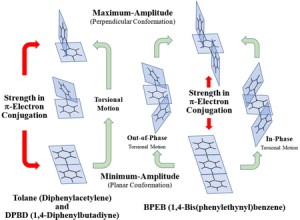[Published online Journal of Computer Chemistry, Japan Vol.23, 1-3, by J-STAGE]
<Title:> p-フェニルエチニル化合物群の π 電子共役の強さを適正に評価する量子化学計算の探索
<Author(s):> 鈴木 椋子, 千葉 康平, 奥山 克彦
<Corresponding author E-Mill:> okuyama.katsuhiko(at)nihon-u.ac.jp
<Abstract:> We searched for quantum chemical calculations that would properly evaluate strength in the π-electron conjugation of a group of p-phenylethynyl compounds determined by molecular spectroscopy with error ranges. The target molecules are tolane, 1,4-diphenylbutadiyne and 1,4-bis(phenylethynyl)benzene. Quantum chemical calculations were performed with B3LYP, CAM-B3LYP, ωB97X-D, M06-2X, and MP2 for theory, and basis sets were explored among the combinations 6-311++G(d) cc-pVDZ, and aug-cc-pVDZ. Because B3LYP calculation is considered to be unskilled at evaluating dispersion force, a dispersion force correction term is added to B3LYP calculation. The least of square of the difference in the strength between observed and calculated was given by calculations with M06-2X/aug-cc-pVDZ. It has, however, often been reported that M06-2X undergoes inappropriate structural optimization. In calculations for 1,4-diphenylbutadiyne, M06-2X was not giving systematic uniform results. Overall, ωB97X-D was a functional function corrected for long-range and dispersion force correction, and it was considered to give good results together with CAM-B3LYP corrected for dispersion force.
<Keywords:> Keyword p-phenylethynyl compounds, strength in π-electron conjugation, dispersion force correction, ωB97X-D/aug-cc-pVDZ, molecular spectroscopy
<URL:> https://www.jstage.jst.go.jp/article/jccj/23/1/23_2023-0044/_article/-char/ja/
<Title:> p-フェニルエチニル化合物群の π 電子共役の強さを適正に評価する量子化学計算の探索
<Author(s):> 鈴木 椋子, 千葉 康平, 奥山 克彦
<Corresponding author E-Mill:> okuyama.katsuhiko(at)nihon-u.ac.jp
<Abstract:> We searched for quantum chemical calculations that would properly evaluate strength in the π-electron conjugation of a group of p-phenylethynyl compounds determined by molecular spectroscopy with error ranges. The target molecules are tolane, 1,4-diphenylbutadiyne and 1,4-bis(phenylethynyl)benzene. Quantum chemical calculations were performed with B3LYP, CAM-B3LYP, ωB97X-D, M06-2X, and MP2 for theory, and basis sets were explored among the combinations 6-311++G(d) cc-pVDZ, and aug-cc-pVDZ. Because B3LYP calculation is considered to be unskilled at evaluating dispersion force, a dispersion force correction term is added to B3LYP calculation. The least of square of the difference in the strength between observed and calculated was given by calculations with M06-2X/aug-cc-pVDZ. It has, however, often been reported that M06-2X undergoes inappropriate structural optimization. In calculations for 1,4-diphenylbutadiyne, M06-2X was not giving systematic uniform results. Overall, ωB97X-D was a functional function corrected for long-range and dispersion force correction, and it was considered to give good results together with CAM-B3LYP corrected for dispersion force.
<Keywords:> Keyword p-phenylethynyl compounds, strength in π-electron conjugation, dispersion force correction, ωB97X-D/aug-cc-pVDZ, molecular spectroscopy
<URL:> https://www.jstage.jst.go.jp/article/jccj/23/1/23_2023-0044/_article/-char/ja/
